




What are Resonance Structures?
The delocalization of electrons in a polyatomic ion or molecule is described as resonance structures, which are sets of Lewis structures. Due to the presence of partial charges and fractional bonds, a single Lewis structure frequently fails to explain the bonding in a molecule/polyatomic ion. Chemical bonding is described using resonance structures in such cases.
A group of two or more Lewis structures that collectively represent the electronic bonding of a single polyatomic species, including fractional bonds and fractional charges, is known as a resonance structure. Delocalized electrons that cannot be described by a single Lewis formula with an integer number of covalent bonds can be described via resonance structures.
For example, resonance structures of phenol.

Resonance Structures of Phenol
Stability of Resonance Structures
The most stable resonance structures are the ones with the least amount of energy. This is essential because a distinct structure's stability determines how much it contributes to the resonance hybrid. The primary contributors are the most stable structures. Minor contributors, on the other hand, are the least stable structures.
Rules for Estimating Stability of Resonance Structure
The resonance structures in which all atoms have complete valence shells (complete octet) are more stable. In the examples shown below, carbon and nitrogen have complete octets and have greater stability than other structures.
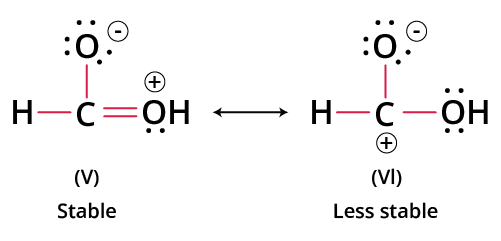
Structure with Complete and Incomplete Octet
The structures with the fewest formal charges are the most stable. The resonance structures with charges are less stable than the ones with less or no charge.
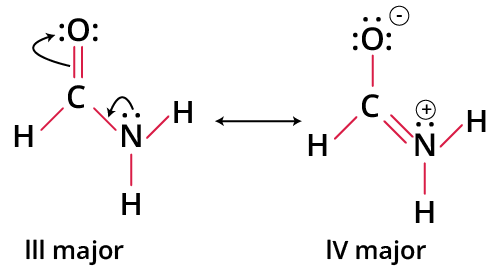
Different structures without charge and with charge
The structures with the positive charge on the least electronegative (most electropositive) atom and the structures with the negative charge on the more electronegative atom are more stable. For example, the second structure is more stable than the first structure.
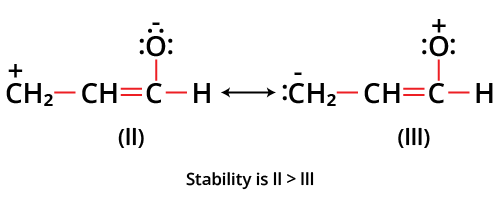
Structures with the charge on different atoms
In the given image II structure is more stable than III structure.
Structures with the lowest formal charge separation are the most stable. The relative placements of the positive and negative charges are the major differences between the two structures shown. Structure A is more stable because its charges are closer together.
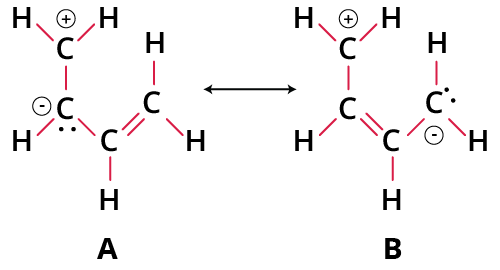
Structures showing charge separation
There is no difference in stability across identical resonance types. With the rules listed above, if there is no difference between the two structures, then they are identical. This indicates that the two structures below are identical in terms of stability and would contribute equally to the resonance hybrid's structure.

Resonating structure of benzene
Examples of Resonance Structures
1. Resonating Structures of Nitrobenzene
The aromatic ring of nitrobenzene has a lower electron density than that of benzene,due to the presence of an electron withdrawing group with a double bond close to the phenyl ring, as indicated by the resonance structures of nitrobenzene. Nitrobenzene has a lower nucleophilicity than benzene because of its phenyl ring. In resonance structures, both ortho and para locations are positive. In an electrophilic aromatic substitution process, the electrophile would therefore react at the meta position rather than these locations.

Resonating structure of nitrobenzene
2. Resonance Structures of Chlorobenzene
Chlorobenzene is a colourless, flammable liquid that smells like almonds. It dissolves in water to some extent but quickly evaporates into the air. It isn't found naturally in the environment. In chlorobenzene, the lone pair present in the chlorine atom shows resonance with the benzene ring which results in an increase in the electron density on the benzene ring followed by an increase in its reactivity towards electrophiles.

Resonating structure of chlorobenzene
3. Resonating Structures of Pyrrole
Pyrrole is a class of heterocyclic organic compounds with a ring structure consisting of four carbon atoms and one nitrogen atom. Pyrrole, a molecule with the chemical formula C4H5N, is the most basic member of the pyrrole family. Alkaloids, a wide class of alkaline organic nitrogen compounds generated by plants, also contain pyrrole molecules.

Resonating structures of pyrrole
4. Resonance Structures of Acetic Acid
The first structure is that of acetic acid in its natural state. This is the most stable resonating structure of acetic acid. The resonance structure in which the carbonyl oxygen has a negative charge and the carbonyl carbon has a positive charge is represented by the second structure. The third structure is a resonance structure in which the carbonyl oxygen is negatively charged, while the hydroxyl oxygen is positively charged.

Resonance structure of acetic acid
Conclusion
A group of two or more Lewis structures that collectively represent the electronic bonding of a single polyatomic species, including fractional bonds and fractional charges, is known as a resonance structure. The most stable resonance structures are those with the least amount of energy. This is essential because a distinct structure's stability determines how much it contributes to the resonance hybrid. The primary contributors are the most stable structure. The resonance structures in which all atoms have complete valence shells (complete octet) are more stable. The stability of resonance structures can be predicted by applying the rules for stability in the sequence given.
FAQs on Stability of Resonance Structures for JEE
1. Explain resonance in aniline.
Aniline is the simplest aromatic amine known which has a rotten fish odour and 5 resonation structure. The lone pair present on the nitrogen in aniline shows resonance with the benzene ring and thus increases the electron density on the benzene ring behaving as an electron donation group. The -NH2 group present on aniline directs the upcoming electrophile to ortho and para position. Due to the involvement of a lone pair of nitrogen with a ring the electron, donating nature of this base decreases.

Resonance structures of aniline
2. What is anthracene? Draw resonance structures of anthracene.
Anthracene is a three-fused benzene ring solid polycyclic aromatic hydrocarbon (PAH) with the formula C14H10. It's a substance found in coal tar. Anthracene is used to make the red colour alizarin, as well as other dyes. Anthracene is colourless but fluoresces blue when exposed to ultraviolet light. Three benzene rings have been fused together to form anthracene. It's also known as para naphthalene or green oil. Delocalization of anthracene will result in four resonance configurations.
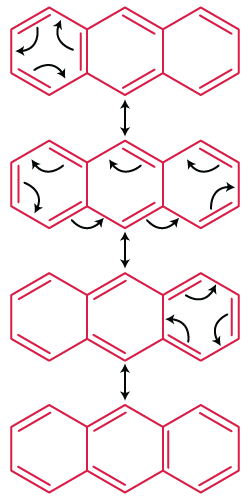
Anthracene resonance structures












